Now & New
Warm Winter in Kure: Comfort in the Usual Places
In countries all across the Northern Hemisphere, January is a bitterly cold month during which people turn to the things, places, and people that bring them comfort to both literally and figuratively warm things up. Most forms of entertainment in the winter tend to take place indoors, and the food served up tends to be hot, hearty, and a reminder of home. Personally, while I may have made Japan my home, since my family doesn’t gather here in Hiroshima, I resort to going to other familiar places in the prefecture—many of which are tourist sites I’ve visited in the past—for a similar sense of comfort.
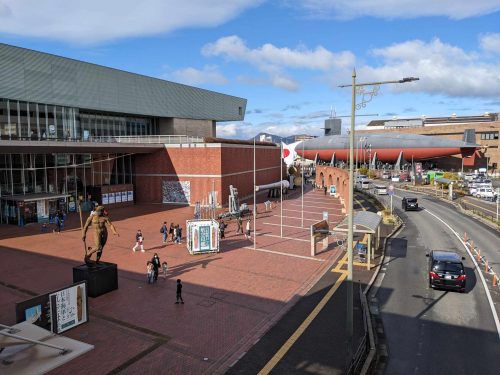
In times like those, I could choose from a long list of destinations, but recently, I had had my eye on Kure. It boasts some impressive museums (i.e. indoor venues for daytime entertainment), is adjacent to Hiroshima City and thus feels like home, but most importantly, Kure (or at least the popular part of Kure near the port) sees warm weather due to being so close to the Seto Inland Sea, perfect for combatting the winter cold. I actually visited Kure multiple times this winter to enjoy various parts of town it had to offer, as well as to try the local comfort food from as many eateries as I could.
Comfort Food Sampling
Kure has several signature dishes known throughout Hiroshima Prefecture, if not throughout the nation. Curry and nikujaga (stewed beef and potatoes) are obvious contenders, but the first item I wanted to tackle was actually a dish more often associated with summer: Kure-style reimen (cold noodles). When it comes to Kure-style reimen, no establishment is more renowned that Chinraiken, and lines form every day of the week!
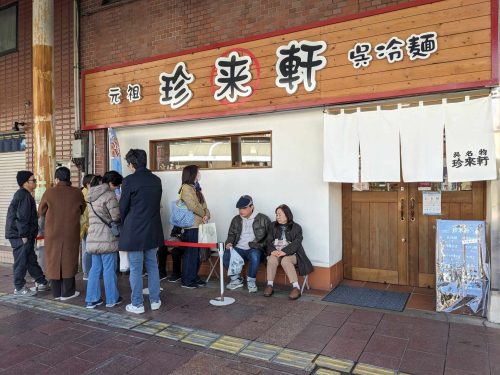
As if the noodles themselves weren’t enticing enough, as a winter exclusive, every order of Kure-style reimen comes with a free cup of soup (it’s tiny, but better than nothing)! Diners buy their tickets from a vending machine upon entering the restaurant, then have a seat, at which point a staff member confirms their order and rips off a stub. As I was seated at the counter, I got a good, long look at the numerous sauces and seasonings meant to be added to the noodles to alter the flavor, and there was a plaque (only in Japanese) explaining how to make the most of the seasonings while eating.
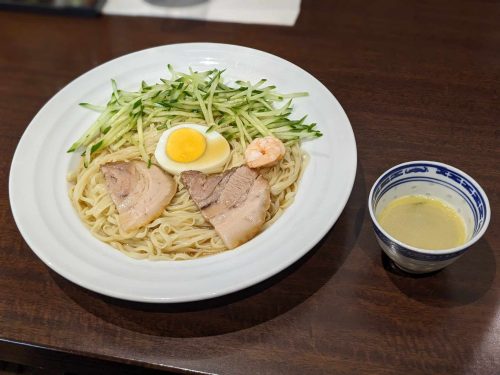
To sum up what the plaque said, the diner should first mix the noodles, shredded cucumber, shrimp, and pork slices well and take the first few bites plain. That’s when the diner ought to know in what direction to alter the flavor using the seasonings. The main sauces involved are chili vinegar and black vinegar; the former ups the spice level (while adding a smidgen of tartness) and the latter sweetens the mixture (thus reducing the piquancy). I had my fair share of fun alternating between those two bottles and experimenting with different flavors using the same dish of noodles. In addition to the vinegars, the usual condiments like black pepper or spicy mustard were still available so those who don’t feel as adventurous can still enjoy their reimen normally.
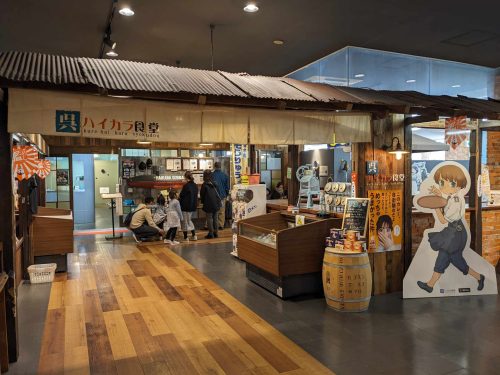
The second comfort food I went for—a recipe that I regularly return to—would without a doubt be Kaiji curry (海自カレー), Japanese curry made just like cooks aboard JMSDF boats and submarines would make. There is a plethora of such restaurants in downtown Kure, but the most iconic of them all would be the High Collar Cafeteria (ハイカラ食堂), which is a short walk from the Yamato Museum. This restaurant’s interior has a submarine theme going on to mimic the environment in which JMSDF members consume their Friday meal, and the staff even dress like sailors. Whether this place dishes out the best Kaiji curry in Kure may be up for debate, but considering High Collar Cafeteria’s fame, location, and how authentic it tries to be, I would certainly recommend it as everybody’s first place to give Kaiji curry a try.
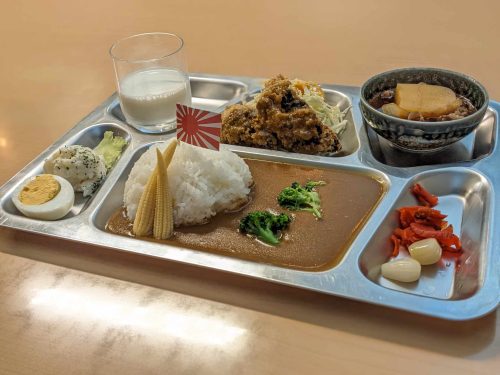
When customers order the “Teppan Set,” they get more than just Kaiji curry on their metal tray. This meal also comes with JMSDF classics like nikujaga, fried whale cutlets, and a glass of milk (other soft drinks can be substituted), everything a sailor needs to stay full and strong enough to defend Japan’s waterways! By the way, the city of Kure holds an annual sticker rally to promote restaurants in the area that serve Kaiji curry, so those hungry for more have an incentive to hit up as many participating restaurants as they can to obtain a bunch of different stickers, but much more can be said about that in another article.
Illumination Road
Winter illuminations across the prefecture—from Hiroshima City to Bihoku Hillside Park—may have ended following the first weekend of January, but Kure’s Illumination Road kept going until the 21st. It’s a miniscule display at a plaza just a 7-minute walk northeast of Kure Station, but it makes for a brief nighttime entertainment option for young couples or families with small children. Those who had an early dinner prior to nightfall might want to stop by to catch the romantic sunset and have a crêpe from the food truck, which makes its crêpes from bamboo charcoal.
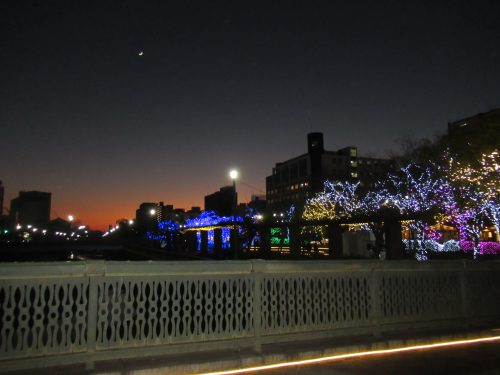
LED lights in all sorts of colors brighten the plaza once the sky goes black, and the wide-open space in the middle lets the little ones run around and play to their hearts’ content. I myself was tempted to join in on the fun, but watching those kids goof off and making sure they didn’t bump into me was entertaining enough for me. My priority was to photograph the illuminated trees, so I quickly turned my attention to the blue end of the venue before being interrupted.
Moment of Joy: Social Butterfly
In the midst of my photography, a little boy asked me to take his photo for some reason I will never know, but I gladly obliged. In addition, this kid was running around shouting, “somebody help!” which attracted attention from everyone in earshot; some of us took him seriously at first, but we then realized he was doing it for attention.
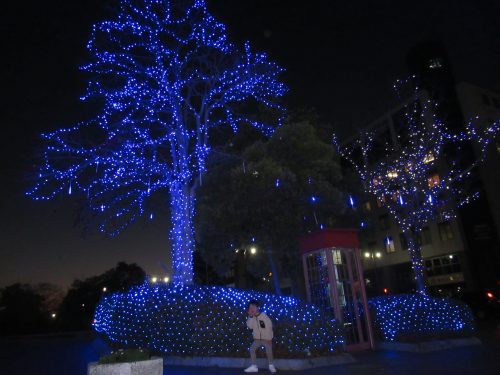
More to the point, this boy really liked this photo I took of him, but as he was too young to give consent to have his photo used, I sought out his parents, who were actually working inside the food truck. When I mentioned that his photo may be used in a website article, the grown-ups were quite impressed with the idea. I for one was thankful that this sociable child inadvertently helped contribute to Joy in Hiroshima with this cute photo.
What A Shipload of Facts!
On a separate day, I dropped by the Yamato Museum for another comfy small-town adventure. My main purpose was to check out the special exhibit on the history Japanese aircraft carriers, not only because I’m into these historical ships, but also because the audio guide was voiced by some pretty big-time voice actors. The Japanese language audio guide was voiced by Saori Hayami, who is known for playing Yor Forger in Spy Family and Shinobu Kocho in Demon Slayer. The English language audio guide was voiced by Shu Uchida, who spent a significant chunk of his childhood abroad and thus acquired a near-native accent when speaking English.
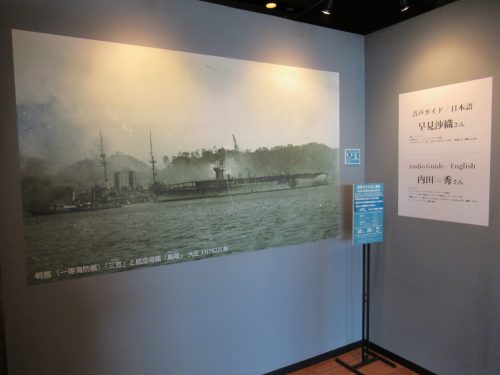
Ms. Hayami and Mr. Uchida take the listener on a journey from the beginnings of the implementation of aircraft in naval combat to the dismemberment of the last remaining aircraft carriers during and after World War II. The special exhibit hall had many objects on display related to the aircraft carriers of yesteryear, including models, artwork depicting the famous vessels, and even a digital database housing the blueprints of the principal aircraft carriers so visitors could learn about the ships’ structures. I was so fascinated by what I learned here that I ended up spending the most time in this part of the museum, but I suppose that’s why the special exhibit costs extra.

I then progressed to the normal exhibition, which always begins with the 1/10th scale model of the battleship Yamato, the largest battleship in history ever built. The rooms on the first floor tell the tale of the Kure Naval Base in the context of the various wars in which the Imperial Japanese Navy fought, but mostly the two world wars of the 20th century. The telling of this history is enhanced with videos, models, and realia related to the ships and the wars in which they fought. The exhibition even goes on to talk about Kure’s reconstruction after World War II and a diving exhibition that investigated the remains of a sunken battleship. The normal exhibition continues in a separate gallery filled with aircraft, torpedoes, and more model ships that winds up into the second floor of the museum.
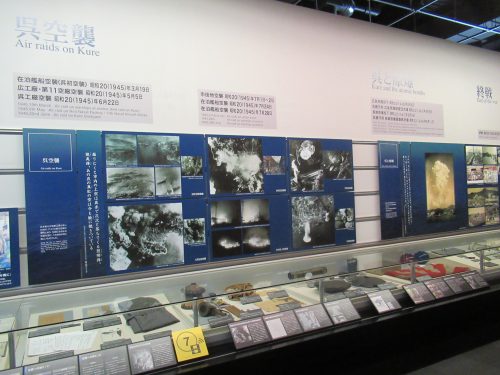
Fun Diversions
I could go into more detail regarding the Yamato Museum’s contents, but there’s already an article solely about that place. Some visitors are also bound to get bored by the sheer amount of information in the special and normal exhibits so it’s important that the facility have spaces where people can take a break from learning. One such space is the terrace on the third floor, from which visitors are treated to an unmatched view of the Steel Whale, a submarine attached to the JMSDF Museum right across the street. This roomy terrace also has vending machines, seating space, and plenty of more room for walking around and taking in the fresh seaside air.
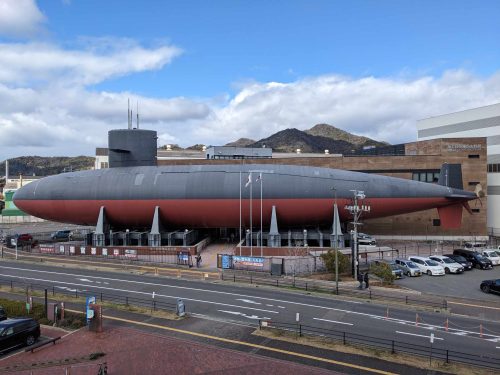
Back inside, the third floor also has a theater room that shows films related to the museum’s contents several times a day, but as the theater room was rented out all day when I visited, I couldn’t see any movies. What was open, though, was the kids’ playroom, which was closed the last time I came in order to inhibit the spread of COVID-19. This one room has a bunch of fun, physical simulations that indirectly teach the wonders of phenomena such as hydraulics, angular momentum, and a boatload of others. Anyone bringing kids to the Yamato Museum will be here for quite a while, but childless me only casually played a few of these simulations before leaving.

While on the topic of science, there’s also a classroom adjacent to the kids’ playroom where a science show is held twice a day on weekends. I had missed the morning show, but made sure to return to catch the afternoon show (the topic is the exact same anyway) after having some Kaiji curry for lunch. The science show is aimed at elementary school-aged children, but anyone is welcome, even grown-ups who came by themselves. I showed up early to the venue, so I had the privilege of sitting anywhere in the room before the show started.
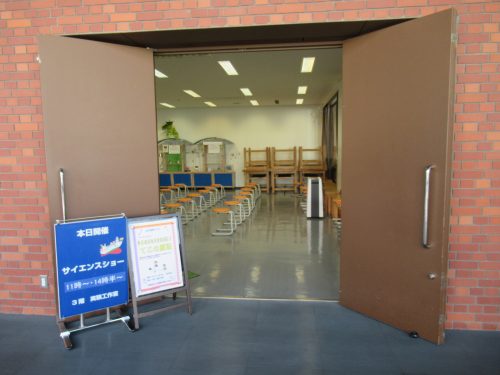
The topic of the day was levers, which can be found in everyday items such as scissors, bottle openers, and staplers. The hosts of the show illustrated the point is a variety of ways, such as letting every member of the audience try bending a spoon, or calling up two kids to arm wrestle using a device with handles of different lengths to jack up the difficulty of one side. What was probably the most exciting was when they had one child ride on one side of a giant scale while the hosts attempted to balance out the weight using things like dumbbells and markers.
As can be seen from the modest nature of that show and the mundane things I saw and did around central Kure, comfort outside of one’s home is a rather easy thing to achieve. I know it may be tempting to only stay home during the chilly winter months, but the occasional outing to a different city like Kure could make winter a more comfortable season, especially considering all the local comfort foods one can taste. Speaking of which, thanks to the sticker rally put on by Kure City, I now know I’ll be back again in order to continue eating at new Kaiji curry restaurants to warm up and spice up my life. While I’m occupied with the surge in comfort food-filled day trips, I’m sure spring will just sneak up on me, and with that, more beautiful days to justify further voyages!

Written by the Joy in Hiroshima Team
